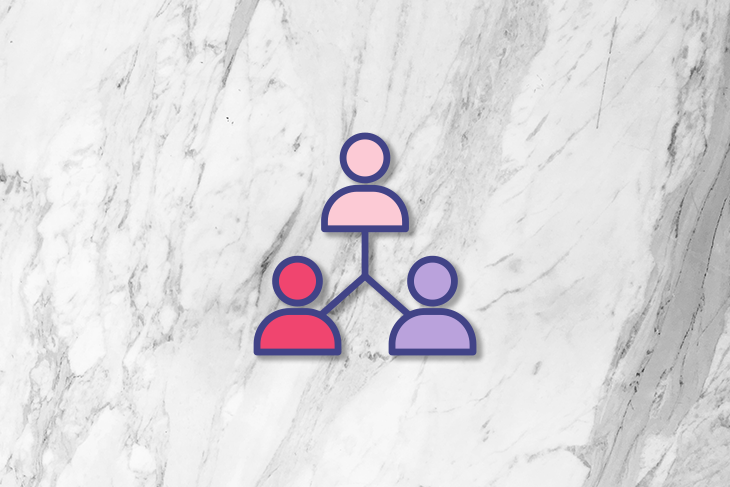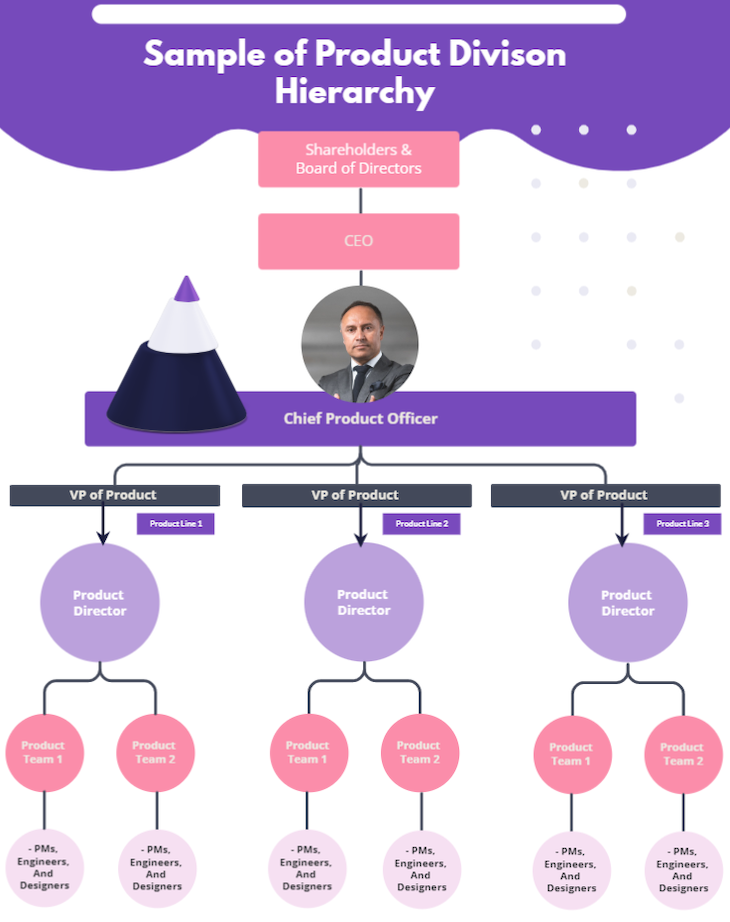In product-led organizations and startups, you will come across different job titles related to the product team. The journey starts with the typical product manager role and goes all the way up to the chief product officer (CPO).

So what does the CPO do? What are their main responsibilities? And what are the skills needed to become one?
This article will shed light on the answers to these questions and provide actionable insights to help you along your journey to becoming a chief product officer.
The structure of the product division varies from company to company. It depends on multiple factors, such as the size of the company, the strategy of the company (product lines and services provided), and the environment the company operates in.
Tech companies usually have a technology department with a product division. The product division is owned and managed by the chief product officer.
The primary responsibility of this division is to develop digital products that bridge specific gaps in the market and solve one or more problems faced by users who fit the ideal customer profile (ICP)
Below is an example of the ideal product division hierarchy for a product-led company with multiple product lines and a massive product division.

The chief product officer is a C-level executive who leads the product department and the product development process. The chief product officer oversees the overall vision across all product lines in the company (product portfolio).
The CPO is the go-to person when it comes to anything related to the product strategy, including discovering the market and the user needs, building products to solve market problems, and diversifying the product portfolio of the company.
The success of the products created by the organization depends on multiple factors. The main factor is the strategic direction of the products and the execution of the planned strategy. This is the biggest responsibility a CPO has. However, the CPO has other critical responsibilities, including:
The chief product officer is the ultimate visionary of the company when it comes to developing the product.
The CPO oversees the market, coordinates with the product teams to research the users, and analyzes all the insights collected by the product teams to come up with a high-level organizational product vision and strategy.
Then the CPO ensures all functional departments and initiatives align with the vision and strategy of the company.
The CPO is responsible for creating, maintaining, and managing a high-level roadmap that covers the big initiatives within the product division.
For example, imagine the product division just discovered a new problem its users face. After conducting some product discovery, the team comes up with an idea that could solve the issue and have a positive impact on business KPIs.
Here, it is the responsibility of the chief product officer to add this initiative to the high-level strategic roadmap, adjust the roadmap accordingly, and present it to the other C-level executives and the board of directors.
The CPO should create a robust product development and management process that focuses on identifying the market and the customer needs regularly and building high-quality products that address the market and the user’s problems.
The CPO is not only responsible for establishing the product management process but also for motivating and supervising the product teams to move the product from the ideation stage and to bring it to life.
The CPO works closely with the senior product managers and directors to identify their weaknesses and improve them. The CPO acts as their mentor and go-to person for any critical situation they face or when they need to make a hard decision.
The chief product officer always has the final say when hiring new product team members. The CPO utilizes different techniques and methods to hire the best product managers out there and maximize the value of the new hires.
Generally speaking, the CPO works with everyone associated with the product division. Starting from the lower-level product teams all the way up to the fellow executives and board of directors. However, the CPO mainly works with three stakeholders: the C-executives, the CEO, and the VPs of product.
The chief product officer works closely with the board of directors to decide the strategy of the products and the offerings of the company. The CPO is responsible for informing the board of directors about any big updates of any product line or any product strategy changes.
The CPO comes packed with data, insights, and initiatives to show to the board of directors and to get their buy-in for the new initiatives.
The CPO usually reports to the CEO, the head of the entire company.
The CEO is mainly in charge of the company’s direction, while the CPO is in charge of the direction of the product portfolio. When it comes to making decisions with the CEO, the CPO is responsible for influencing the direction of the company from a product portfolio standpoint.
The CPO helps the CEO target new potential markets and satisfy unmet needs while maintaining a top-notch product portfolio.
The CPO works with the VPs of products to get updates on the progress of the different product lines and reflect it back to the board of directions and CEO. The CPO also mentors them on different product management aspects and makes sure that what the VPs’ teams build is fully aligned with the overall vision and strategy of the product portfolio of the company.
Chief product officers come with a good mix of technical and soft competencies. Those competencies are the ones needed to build a company-wide product strategy and a robust team that helps with executing this strategy.
Some skills required to be a successful CPO include:
Chief product officers constantly communicate. The core of the CPO job is communication.
Some examples of when the CPO would use communication are:
Chief product officers always envision the future state of the company, and the product portfolio. They see the big picture of the market and their users’ needs, analyze heavy data and information to spot trends and problems, and come up with products and solutions to the issues.
The chief product officer works with tons of stakeholders. They always have to persuade the board of directors and CEO on why the company’s product portfolio follows that strategy. The CPO should always be diplomatic and packed with data regarding the persuasion of the strategy and initiatives.
The company relies upon the CPO to make decisions regarding the direction of the product. The CPO usually faces different opinions, possible directions, and visions for their product portfolio. The CPO, in this case, and many other cases, has to be assertive and make the right decisions at the right time.
The CPO leads a massive product team with multiple product lines/verticles. The CPO influences and motivates his diverse product teams with different backgrounds to fulfill the strategy and achieve the company’s vision.
The CPO assigns each product line to one product director and one or more product teams. Thus, the CPO must know how to delegate effectively, identify the strengths and weaknesses of each team member, and map employees to the product they will be working on.
We reviewed more than 100 chief product officers’ LinkedIn profiles across three regions: Europe (UK and Germany), North America (USA), and Asia (Singapore). Here are the common qualifications we found:
CPOs must go through the entire product life cycle and be experienced product managers and executors before they can go into a CPO role. Most CPOs come from a product management background where they’ve built world-class products with cross-functional teams and generated colossal revenue from those products.
As per our observations, we found out that most CPOs hold a Master of Business Administration (MBA), and some of them hold a Master of Science (MS) in computer science. We also found a significant number of CPOs hold more than one graduate degree in areas like information technology, innovation, and marketing.
Most C-executive-level roles are gained via networks and referrals. Most of the CPOs we found through Linkedin have a large number of connections and engage with the product community constantly.
In the case of being a chief product officer, hands-on experience and graduate degrees are far more important than any extracurricular course or certification. However, some courses are great for teaching the skills needed for aspiring CPOs.
Kellog business school provides a great executive program for CPOs. The course digs deeper into topics like product strategy foresight, financial analysis for product leaders, omnichannel marketing, and leading and sustaining a culture of innovation. The program is a 12-month program and has a competitive applicant pool.
MIT’s school of business offers a course developed by world-class CPOs from top tech companies. The course takes aspiring CPOs on a journey where topics like designing two-sided markets, product life cycle assessment, and tech product strategy are discussed deeply. The program is a 12-month program and an annual intake.
The chief product officer is the leader of the product organization and the owner of the product portfolio. The CPO manages every aspect of product while keeping the other departments aligned on the product strategy and vision.
There are only a few chief product officers in the world right now since it is a relatively new role. Thus, to be one, you have to have some intensive experience, one or more graduate degrees, and some outstanding achievements in the world of product management.
Featured image source: IconScout

LogRocket identifies friction points in the user experience so you can make informed decisions about product and design changes that must happen to hit your goals.
With LogRocket, you can understand the scope of the issues affecting your product and prioritize the changes that need to be made. LogRocket simplifies workflows by allowing Engineering, Product, UX, and Design teams to work from the same data as you, eliminating any confusion about what needs to be done.
Get your teams on the same page — try LogRocket today.

Most teams fail at autonomy. Learn how clear rules help product teams move faster without micromanagement.

A practical framework for PMs to use AI in ideation without sacrificing judgment, strategy, or decision quality.

A practical five minute revenue estimation method to help product managers compare ideas, drop low impact features, and prioritize smarter.

A practical guide for PMs who want to stop being bottlenecks, delegate smarter, and lead teams effectively with a clear ownership framework.